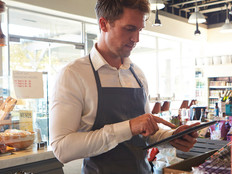Digital Kiosks or Mobile Payments: Which Is Better for Retailers?
Digital kiosks at retailers and restaurants are coming, in a major way. In February, fast food chain Wendy’s confirmed plans to install self-ordering kiosks in 1,000 of its stores — about 16 percent of its total locations — by the end of the year.
Such kiosks help restaurants cut down on labor costs and can make transactions more efficient. However, retailers also are investing in mobile payments, both in terms of mobile applications and the ability to accept such payments at checkout. Mobile payments, especially if conducted via retailers’ own apps, give merchants a wealth of data about what customers buy and where and when they make purchases, allowing merchants to better tailor offers.
Which is a better investment for retailers? The answer is it’s not an either-or choice; the two technologies deliver different benefits to retailers’ bottom lines and relationship with customers. Each retailer must evaluate the costs and benefits of deploying kiosks and mobile payments.
The Case for Digital Kiosks in Retail
How big is the retail kiosk market? Numbers are a bit hard to come by, but research firm Stratistics MRC said in an October 2015 report that the global interactive kiosk market amounted to $1.2 billion in 2014, with the market expected to grow by nearly 15 percent per year to reach $2.88 billion by 2022. Meanwhile, according to GPShopper’s “Reality of Retail Tech” survey, released in March and conducted online with help from YouGov, 71 percent of consumers are aware of self-checkout technology, the most of any retail tech. Further, the report found that consumers say self-checkout is the most useful technology at improving their shopping experience. “There is a huge amount of pull from (franchisees) in order to get them,” Wendy’s CIO David Trimm said about kiosks during the company’s investors’ day in February, according to The Columbus Dispatch.
“With the demand we are seeing ... we can absolutely see our way to having 1,000 or more restaurants live with kiosks by the end of the year.”
The newspaper reports: “Trimm said the kiosks accomplish two purposes: They give younger customers an ordering experience that they prefer, and they reduce labor costs. A typical store would get three kiosks for about $15,000. Trimm estimated the payback on those machines would be less than two years, thanks to labor savings and increased sales. Customers still could order at the counter.”
Kiosks also can improve order accuracy and allow customers to linger while deciding what to order.
More than 40 percent of millennials said they would use kiosks in a restaurant, compared with nearly 30 percent of all customers, according to a recent report from food-service research and consulting firm Technomic, the Los Angeles Times reported.
However, the Dispatch reports that Wendy’s thinks “mobile ordering and payment, via smartphones, eventually will overtake kiosks and cash registers. One reason: they provide data. Wendy’s wants to know more about its customers to better tailor offers and understand trends. But until then, kiosks are the hot thing.”
Mobile Payments Deliver Customer Data
Mobile payments are growing in popularity, especially among millennials, but are not yet a widespread payment method, according to research firm eMarketer.
The firm reported in November 2016:
“Despite double-digit growth this year and next, Americans’ use of mobile wallets like Apple Pay, Android Pay and Samsung Pay, as well as branded apps that include mobile wallets like the Starbucks app, Walmart Pay and CVS Pay, will not reach mass adoption in the foreseeable future. This year, 38.4 million Americans 14 and over will have used their mobile phones to pay at the point of sale at least once in the preceding six months. That’s just 19.4% of U.S. smartphone users. By 2020, that figure will grow to 33.1% of smartphone users.”
What is the key benefit for retailers of investing in apps and point-of-sale terminals to enable mobile payments? It’s all about getting access to their customers’ data. Apple Pay, for example, improves customers’ security through the tokenization of payments, so that credit card details are not exchanged for each purchase. However, the service also masks payment data, keeping retailers in the dark.
As TechCrunch reported last year: “While it is true that Apple doesn’t directly collect specific customer data, they do hold the keys to transactional data. Simply, merchants get less data from Apple Pay transactions than from traditional transactions done at the terminal. Retailers lose almost arbitrarily and Apple gains location data that is aggregated to ‘improve Apple’s wider services.’”
Security of payments is important to retailers, but getting data on customers is key. “In today’s world, credit cards, loyalty programs and mobile payments are all fueled by data, and the most powerful brands are the ones that own that data rather than simply facilitate transactions,” TechCrunch notes.









